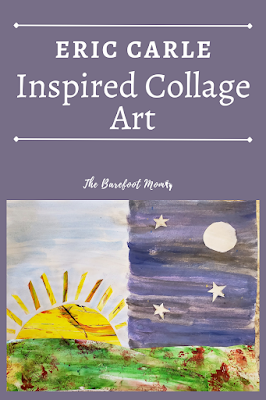I'm a big Eric Carle fan. There's just something really fun about his artwork, so when my daughter asked me how he made his illustrations I thought it would make an excellent art lesson!
Who was Eric Carle?
Eric Carle was an American author and illustrator of children's books.
His books include:
The Very Hungry Caterpillar
The Very Busy Spider
The Grouchy Ladybug
The Mixed Up Chameleon
The Tiny Seed
Papa, Please Get the Moon for Me
Eric Carle was born on June 25th 1929 in Syracuse, New York. At age 6, his family moved to Stuttgart, Germany. He attended and graduated from the local art school there. He returned to New York in his twenties and landed a job as a graphic designer with The New York Times.
Author Bill Martin Jr. noticed an illustration of Carle's in an advertisement and asked him to collaborate on a children's book. Brown Bear, Brown Bear, What Do You See? written my Bill Martin Jr. and illustrated by Eric Carle was published in 1967. It quickly became a bestseller.
Eric Carle went on to illustrate over 70 picture books, many of which he wrote himself.
Resources for Learning About Eric Carle
-About Eric Carle from The Carle Museum of Picture Book Art
-The Life of Eric Carle video
-Who is Eric Carle by Stephanie Sabol
Eric Carle Style Collage Art
Eric Carle's illustrations are collages made from pieces cut from painted tissue paper.
He would start by painting layers of bright acrylic paints on a sheet of tissue paper. He used a lot of tools and other items to add texture like sponges, forks, paint brushes, etc...
He had drawers full of these sheets of painted tissue paper, all unique. When he wanted to create an illustration he would cut shapes and pieces from the painted tissue paper sheets and assemble them into a collage style picture on a large sheet of paper. Sometimes he would add details with pen.
Learn more about the Eric Carle process with this short video: https://youtu.be/zqqtq1UaTiE
Then try making your own Eric Carle inspired collage!
Start by making painted sheets like Eric Carle's. I recommend using white construction paper or white printer paper instead of tissue paper though. It is much easier to work with. Use lots of bright colors and experiment with adding textures. Some tools and items to try for texture are sponges, a fork, your fingers, a comb, the back of a paint brush. Make several different sheets and set them aside to dry.
While your sheets of painted paper are drying, think about what you want to make. Eric Carle illustrated a lot of books about insects and other animals, but you could choose anything that you want. Draw a rough sketch.
After your sheets of painted paper are dry, cut out shapes and pieces and assemble them to make the animal or picture that you wanted to make. Glue them into place on a piece of cardstock or construction paper.
What's your favorite Eric Carle book?
Tell me in the comments!
If you enjoyed this post check out:
-STEM Art: 21 STEAM Art Project Ideas
Follow me on







Comments
Post a Comment